Deng’s reforms had largely disadvantaged the educated class. One popular slogan during the mid-1980s was that, “Those who hold scalpels earn less than those who hold eel knives.”
In the spring of 1989, more than one million Chinese students and workers occupied Beijing’s Tiananmen Square and began the largest political protest in communist China’s history. Six weeks of protests ended with the Beijing massacre of 3-4 June.
In May 1986, 30 years after intellectuals were expelled by Mao Zedong into the countryside, the first student call for democracy took place. Even though it was quickly put down, the demonstration’s leader, Fang Lizhi, became a hero to students and liberal intellectuals. They were against Japanese investment in China and organised protest marches and demonstrations. These spread to other universities. In the aftermath of the 1986 crackdown, students began to assume the leadership of China’s reform movement. The Chinese regime tried to paint the leaders of the 1986 demonstration as hooligans, and spread the idea that the students were misled.
15 APRIL – HU YAOBANG’S DEATH
In 1987 Hu Yaobang, a liberal CCP general-secretary who was popular among students, was dismissed by Deng for not acting firmly against these protests. It seemed to some that Hu sympathised with the student protests. In April 8, 1989, Hu suffered a heart attack. Hu died several days later. Western reporters observed that Hu’s obituary was intentionally “glowing” in order to divert suspicion that the Party had mistreated him. At the memorial service, Hu’s widow blamed Hu’s death on how harshly the party and Deng Xiaoping treated him. Public mourners at Hu’s funeral lined up ten miles long, a reaction which surprised China’s leaders. Shortly after Hu’s funeral, students in Beijing began petitioning the government to officially reverse the verdict that had led to Hu’s “resignation”, and to provide a more elaborate public funeral.
18-21 APRIL – DEMONSTRATIONS SPREAD
This escalated the confrontation between the government and students. Numbers in Beijing swell into thousands in the following days, and demonstrations spread to cities and universities nationwide. Students, workers and officials shout slogans calling for greater freedom and democracy and an end to what they called dictatorship – others complain about inflation, salaries and housing.
April 22 APRIL – HU’S MEMORIAL
50,000 students marched to Tiananmen Square to participate in Hu’s memorial service, and to deliver a letter of petition to Premier Li Peng. The mourning became a public conduit for anger against perceived nepotism in the government, the unfair dismissal and early death of Hu, and the behind-the-scenes role of the “old men”, officially retired leaders who nevertheless maintained quasi-legal power, such as Deng Xiaoping. The protests eventually escalated into the Tiananmen Square protests of 1989. Hu’s promotion of the ideas on freedom of speech and freedom of press greatly influenced the students participating in the protests.
Soon, crowds of non-student Beijingers (angry at corruption, rich getting richer, etc) enthusiastically join in. In the weeks that followed, Tiananmen Square was the scene for daily rallies which demanded democratic reforms. The students occupied the square for several weeks, in spite of being ordered to leave. The crowd swells, spilling over nearby streets. After seven weeks of government inaction, the crowd has mushroomed to an estimated 2-3 million.
4 MAY MOVEMENT
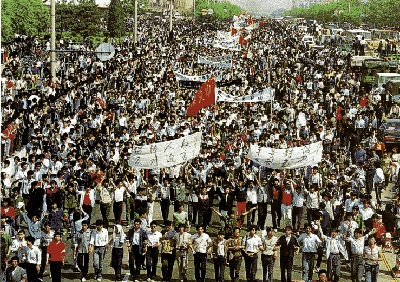
Initiated by students, more than 100,000 march through Beijing. In addition to the students, workers and journalists express their demands. Similar rallies are held in at least five cities across the country. The Chinese students staged the biggest pro-democracy demonstrations of their kind since the communists came to power 40 years ago. The action coincides with the 70th anniversary of the 4 May movement, an intellectual movement that wanted a stronger China.
May 4 1989 = 70th anniversary of the May 4th 1919 Movement.
This “May Fourth Movement” (or ”New Culture Movement”) became a catalyst for change in China then.
13-15 MAY – HUNGER STRIKE – GORBACHEV’S STATE VISIT
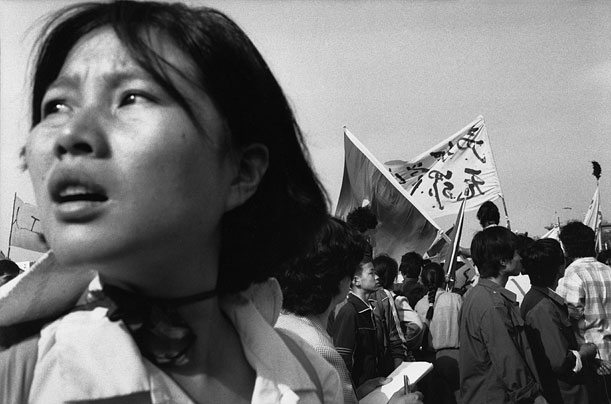
Mikhail Gorbachev arrives in Beijing for the first Sino-Soviet summit in 30 years. His visit is intended to put a formal end to years of hostility between the two communist nations. The Soviet leader’s official reception had to be shifted to the airport to avoid passing through Tiananmen Square where over a thousand students were on indefinite hunger strike, pressing for political reforms – a huge embarrassment for the government.
19 MAY – ZHAO VISITS SQUARE
Zhao Ziyang visits students on Tiananmen Square, and makes a final, unsuccessful appeal for a compromise. He is accompanied by Li Peng, his hard-line rival.
20 MAY – TROOPS MOVE IN
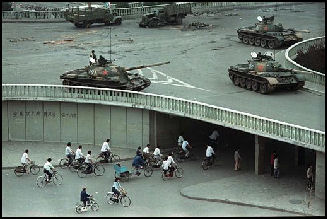
Martial law is declared in several districts in Beijing and troops move towards the city centre. A huge number of civilians block their convoys, setting up barricades on streets. The soldiers have been ordered not to fire on civilians.
24 MAY – 3 JUNE – HEIGHTENED TENSIONS
The demonstrations continue with almost no visible security presence – there is a jubilant atmosphere in Tiananmen Square. However, at government headquarters, China’s leaders plan a new offensive to end the demonstrations and end the chaos in China’s capital.

On May 29th, students from the Beijing Art Institute raised a 30-foot-high statue called the “Goddess of Democracy”, which was model after the Statue of Liberty, near the Monument of People’s Heroes at the center of the square.
The leaders hesitated for so long in acting against the students because:
- They had to be certain of the loyalty of the People’s Liberation Army.
- There were many foreign journalists in Beijing. Force might have a bad effect on opinion abroad and reduce investment in China.
China’s leaders, however, made sure that they had the loyalty of the People’s Liberation Army. Nevertheless the first troops to arrive in Beijing seemed unwilling to use force. Deng now decided on force to remove the students.
On the evening of June 3d, troops broke down the barricades erected by the protestors and opened fire. Thousands of PLA soldiers begin moving towards the centre of Beijing. People flood onto the streets to try to block them, setting up barricades along routes into Tiananmen Square. As the army tries to break through in armoured personnel carriers, some troops open fire with guns loaded with live ammunition, killing and injuring many unarmed citizens.
A tank crushed the “Goddess of Democracy” statue, but in 1994, supporters of the human rights movement in China gathered to unveil a bronze statue modeled after the original.
4 JUNE – ANGER AND SHOCK
Tiananmen Square is cleared after a night of the worst bloodshed ever seen in Beijing under communist rule. Thousands of angry and curious residents crowd up. The soldiers open fire again. The government hails the military intervention as a great victory.
But Peking Radio’s English language service, in an act of defiance, says thousands of innocent civilians were killed. The government-run radio calls the act a gross violation of human rights and a barbarous suppression of the people.
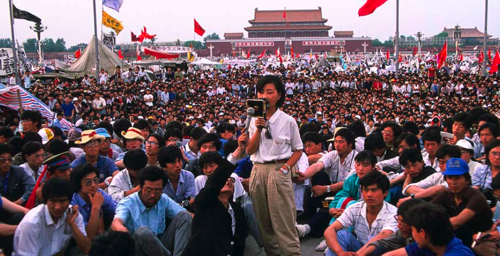
By the early hours of 4 June all resistance had been crushed and the evidence that a massacre had occurred removed.
The incident is today referred to by Chinese as “six-four” (for June 4).
5 JUNE – “TANK MAN”
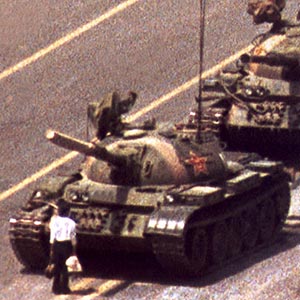
Internationally, the image of the lone man in front of the tank has come to symbolize the events at Tiananmen Square in 1989, and is widely considered one of the most iconic images of the 20th century.
The army now has complete control of Beijing – but it is yet to witness a staggering act of defiance. “Tank Man”, or the “Unknown Protester”, is the nickname of an anonymous man who stood in front of a column of Chinese Type 59 tanks the morning after the Chinese military forcibly removed protesters from in and around Beijing’s Tiananmen Square on June 5, 1989. The man achieved widespread international recognition due to the videotape and photographs taken of the incident.
9 JUNE – DENG XIAOPING APPEARS
China’s de facto leader Deng Xiaoping appears for the first time since the brutal crackdown.
In a speech to military officers he praises their efforts, and blames the turmoil on counter-revolutionaries who wanted nothing less than to overthrow communism.
Why was the massacre carried out?
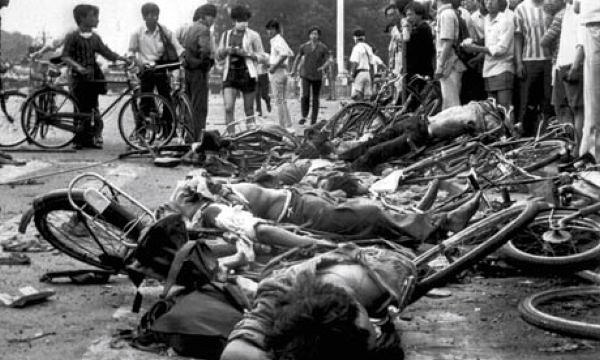
There are several possible explanations:
- The Chinese government insisted that the students had foreign support and were trying to undo the Communist revolution.
- Deng certainly would not tolerate any opposition and saw the student movement as a genuine threat to his leadership.
- There was a power struggle to see who would take over once Deng retired or died. This was between Zhao Ziyang and Li Peng. Li Peng encouraged force against the students, believing this would win him the support of Deng.
CONSEQUENCES IN THE WORLD
Tiananmen Square Protest was an event that shocked the world, and the number of protestors who were killed at in the incident still remains a mystery. The incident had become a global symbol and was considered one of the most terrifying events in the modern China history.
Many people around the world witnessed the Chinese government who showed no mercy killing unarmed Chinese civilians and pro-democracy protestors at Tiananmen Square. After June 4, 1989 China has received criticism around the world, mainly from Western countries in North America, Europe, and some Asian countries.
To retort criticism around the globe, the Chinese government insisted the incident was an internal affair and the force was necessary to maintain “social stability”, and China also declared that it was a “counter-revolutionary rebellion” that had to be stopped”.
The Tiananmen Square incident had certainly damaged China’s international image in the world.
To date, the incident remains one of the most politically sensitive and suppressed topics in China. Indeed, the Tiananmen event has become a taboo subject in China, and Chinese civilians have been forbidden to discuss it in the public.
Aftermath
Until today, many countries around the world still continue to urge the Chinese government to reveal the truth of incident and release hundreds of people who are still imprisoned because of the Tiananmen Square protest. In 2009, the US Secretary of State, Hillary Clinton, released a statement to “urge Beijing to account for those killed in a crackdown on pro-democracy demonstrations in Tiananmen Square 20 years ago”. However, the Chinese government has continued to conceal the details of the event from the public and has tried to avoid discussing the issues relating to this incident.
Meanwhile, the Chinese government refuses to apologize to the civilians who were killed in this incident, and the government hasn’t set a memorial day for those who lost their lives in the event.
Censorship
The Chinese government has tried to erase every trace of the Tiananmen Square incident and prohibit civilians from exchanging information related to the event.
Due to technology improvement the usages of digital and broadband transmission in China are rapidly increasing, the Chinese government has advanced their censorship system, which is known as the “Great Firewall China”. This system allows the government to inspect computer system and communication network. As a result, when Chinese users try to search articles, videos, photos, and wordings related to the anniversary of the Tiananmen Square Protest, all the relating information would be blocked. Violators who tried to publicize the Tiananmen incident will face the consequences of imprisonment or receiving fine. For instance, in 2004, a Chinese journalist, sent to a western website a government document banning the news media from mentioning the 4 June anniversary. He was arrested and is now serving a ten-year prison sentence”.
Moreover, protests that draw crowds and activities and attempt to remind people about the incident are strictly banned at the square. Thus, when foreign TV channels broadcast news and report about the anniversary in China, it would either be blacked out or go blank.
Also, “Tiananmen Mother”, a group comprising the parents, relatives, and friends of victims of the incident said that, “the result that young people born in the 1980s and 1990s refuse to believe that this event has ever happened”!
Freedom:
After June 4, 1989 China had quickly transformed itself into one of the world fastest growing economies. Although China is trying to improve its global status by gradually becoming a free market country, there are still many restrictions within the country. The international opinion and criticism pushed China to introduce democracy reform and offer Chinese people the freedom. However, many people in China argue that “China is not ready for a democracy society” even though they believe Chinese people have more freedom now than in 1989, especially the ordinary people in non-governmental activities.



You must be logged in to post a comment.